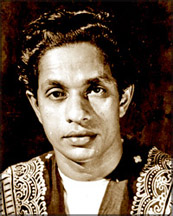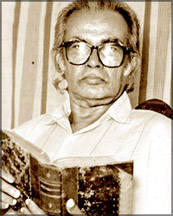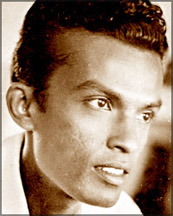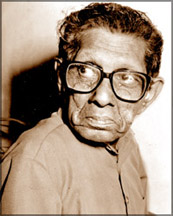A Critique on the State Sinhala Drama Festival of 1966
'An actor is one who is made and not one who is born' should be the
motto of Sinhala theatre
Subject matter of realistic conversational original Plays in 1960's
Prof. Ariya Rajakaruna
Translated by Ranga Chandrarathne
 |
 |
|
W.B. Makuloluwa |
Piyasena Costa |
This is a translation of a critique by Prof. Ariya Rajakaruna. He
served as the Head of the Department of Sinhala of the University of
Peradeniya. He is currently a visiting lecturer attached to the
Department of Fine Arts and Sinhala.
This is the only comprehensive review written on any State Sinhala
Drama Festival held during the last five decades. This review was first
published in 1967. This critique has been translated for the first time.
Continues from the last week
Stylist drama has been evolving as a distinct form and a tradition
undergoing various experiments. The principal characteristics of theses
dramas are singing, instrumental music and dancing.
Attempts have been made to create diverse zests through such dramas.
It seems that this type of drama is a suitable medium for humour and
irony. Adapting dramas with no dramatic qualities would contribute to
the degeneration of this tradition. Attempts have been made to diversify
them in terms of styles of acting.
 |
 |
| Chandrasena
Dassanayake |
Bandula
Jayawardene |
However, the monotonous style of acting and in some instances, the
unpalatable acting may have made audience tired of. The zest created by
singing, instrumental music and dancing should not be allowed to
overwhelm the dramatic zest in this type of dramas.
Musical drama is also developing as a distinct form and tradition.
However, using folk songs for musical dramas alone is not sufficient. A
tradition of children's drama is developing up through school dramas.
Dramatists have understood that zest can be intensified by
stage-decorations, costume design, make-up and lighting. However, some
dramatists could not derived maximum from them. Those dramatists who
have a better understanding on stage techniques, these features and by
other means attracted the spectators.
There is no marked improvement in Sinhala theatre. Sinhalese actors
and actresses do not consider acting as an art that should be mastered
with vigour. Those actors and actresses who have been acclaimed in
previous festivals showed no special talents this time. For some,
instead of improvement in acting, there is a decline.
There is a static acting irrespective of the nature of the character
portrayed on stage. Although the actors and actresses showed some
talents in portraying village and houmourous characters, portraying
complex characters is proved a difficult task.
|

Bandula Jayawardene’s Bihivanu Bosathanani |
The facial expressions of those actors and actresses who portrayed
'dark' characters are static from start to the end. They failed to
change facial expressions to suit the situation.
Actors or actresses who come to the stage should be able to loud
speak and to speak clearly to the audience. Most of the actors and
actresses could not do even this task. Some were ignorant of the fact
that the manner in speaking should be changed with an intonation to suit
the situation.
Some actors and actresses had no understanding of how they should
stage-manage different parts of the body in action. There were numerous
occasions that revealed that actors and actresses did not know how to
conduct themselves on stage when walking and not engage in conversation.
It seems that some actors and actresses only read the relevant portion
of the text and not the entire script of the drama.
To be successful, the entire cast should get together and act in
conjunction. Acting as a group with team spirit is very rare. It seems
that actors and actresses though that individual acting out mastering
one another would suffice.
There were many instances where actors and actresses forgot lines and
demonstrated weak acting. As they forgot lines, there were instances
they improvised lines and continued the conversation. There were many
such occasions with the intension of amusing the audience.
These weaknesses contributed to make production scrawny. Almost all
productions, weak actors and actresses out numbered the talented ones.
Acting in midst of weak actors and actresses resulted in weak
performance on the part of talented actors and actresses.
Most of the actors and actresses on Sinhala theatre were in their
youth. Their immaturity in acting was out shown unnatural, especially
when they portrayed middle-aged and old characters.
One of the reasons of weak acting is that most actors and actresses
confined themselves to a drama. For the advancement of Sinhala Theatre,
it is essential to set up an institute, which provides all-round
training in drama and theatre. 'An actor is one who is made and not one
who is born' should be the motto of Sinhala theatre.
In some instances as the script-writer, director and the main
character was played by the same person, defects in the script
confounded in the production. Director should have a comprehensive
knowledge of drama and theatre. Above all, he should posses a sharp
insight into life. It has been proved that some directors have poor
sense of observation.
They have little understanding of human behaviour and dispositions on
different occasions. This has been the main cause for unnatural acting
on the part of most of the actors and actresses.
Some directors failed to select suitable actors and actresses for the
drama. Some did not posses even a little understanding of training
actors and actresses for the performance. Therefore, actors and
actresses performed on their own. Some directors had no experience in
producing a drama.
Audience is emerging who watch dramas by habit. They used to watch
drama irrespective of it being successful or not. Disturbances for
acting were rare on the part of the audience. They have acquired certain
understanding on theatre. In determining success or failure of a drama,
they use criteria with a degree of accuracy.
There is no criterion for criticising Sinhala dramas which have been
produced according to diverse traditions. In keeping with the tradition
of drama, criticism should also be changed to a certain degree. Some
critics are ignorant of Western norms of criticism.
Some do not know about Eastern tradition of dramas. There those two
types of critic, on many occasions, arrived at wrong conclusions. Some
do not consider the dramas with songs, instrumental music and dancing
and made according to indigenous tradition, as dramas since they did not
fall into the category of drama according to Western criteria. |

